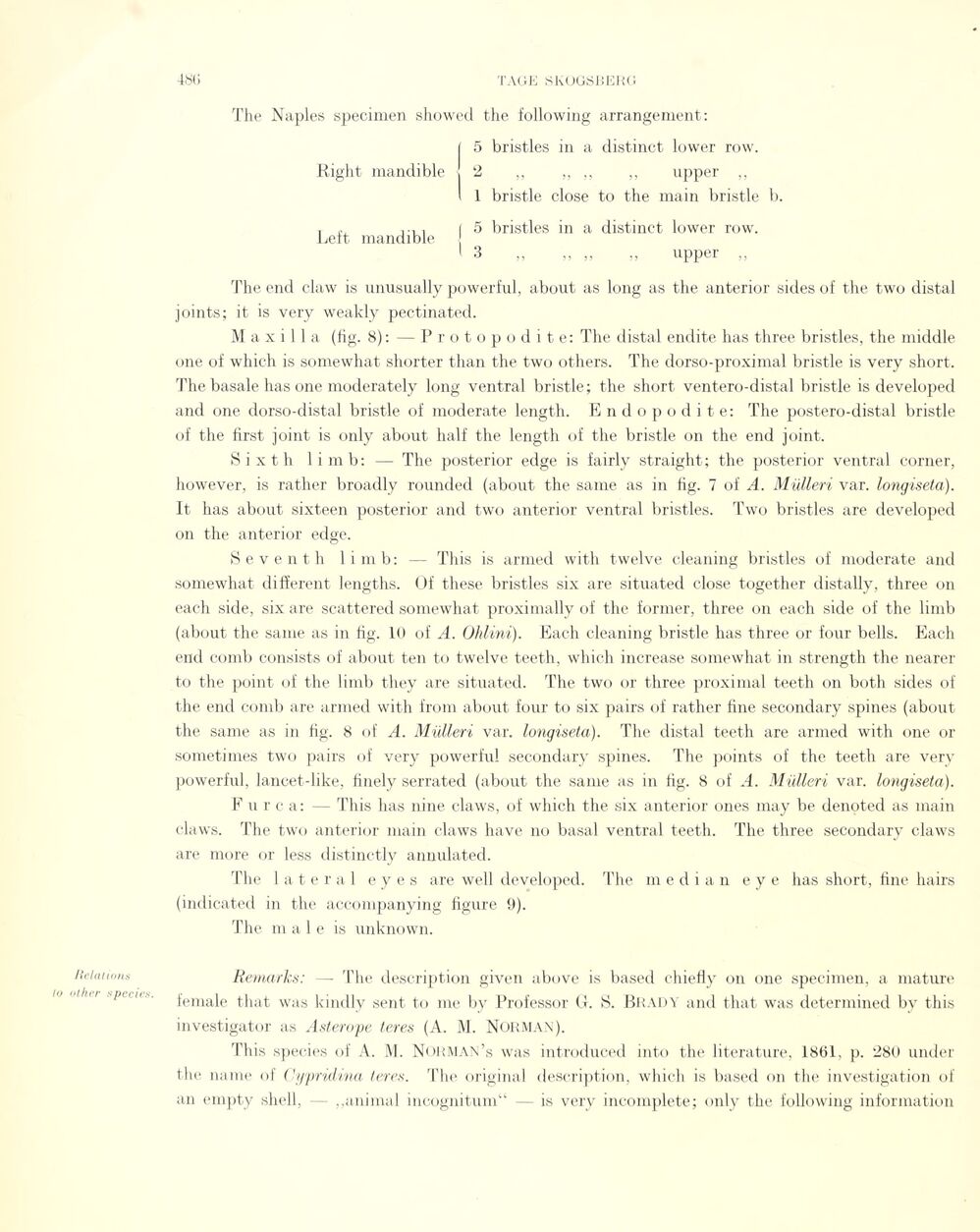
Full resolution (JPEG) - On this page / på denna sida - Sidor ...

<< prev. page << föreg. sida << >> nästa sida >> next page >>
Below is the raw OCR text
from the above scanned image.
Do you see an error? Proofread the page now!
Här nedan syns maskintolkade texten från faksimilbilden ovan.
Ser du något fel? Korrekturläs sidan nu!
This page has never been proofread. / Denna sida har aldrig korrekturlästs.
The Naples specimen showed the folio wing arrangement:
[ 5 bristles in a distinct lower row.
Right mandible 2 ,, ,, ,, ,, upper ,,
Left mandible
1 bristle close to the main bristle b.
5 bristles in a distinct lower row.
3 „ „ „ „ upper „
The end claw is unusually powerful, about as long as the anterior sides of the two distal
joints; it is very weakly pectinated.
Maxilla (hg. 8): — Protopodite: The distal endite has three bristles, the middle
one of which is somewhat shorter than the two others. The dorso-proximal bristle is very short.
The basale has one moderately long ventral bristle; the short ventero-distal bristle is developed
and one dorso-distal bristle of moderate length. Endopodite: The postero-distal bristle
of the first joint is only about half the length of the bristle on the end joint.
S i X t h 1 i m b : —■ The posterior edge is fairly straight ; the posterior ventral corner,
however, is rather broadly rounded (about the same as in hg. 7 of A. Mulleri var. longiseta).
It has about sixteen posterior and two anterior ventral bristles. Two bristles are developed
on the anterior edge.
Seventh 1 i m b : — This is armed with twelve cleaning bristles of moderate and
somewhat different lengths. Of these bristles six are situated close together distally, three on
eacli side, six are scattered somewhat proximally of the former, three on each side of the limb
(about the same as in fig. 10 of A. Ohlini). Each cleaning bristle has three or four bells. Each
end comb consists of about ten to twelve teeth, which increase somewhat in strength the nearer
to the point of the limb they are situated. The two or three proximal teeth on both sides of
the end comb are armed with from about four to six pairs of rather fine secondary spines (about
the same as in fig. 8 of A. Mülleri var. longiseta). The distal teeth are armed with one or
sometimes two pairs of very powerful secondary spines. The points of the teeth are very
powerful, lancet-like, finely serrated (about the sanie as in fig. 8 of A. Mülleri var. longiseta).
F u r c a: — This has nine claws, of which the six anterior ones may be denotecl as main
claws. The two anterior main claws have no basal ventral teeth. The three secondary claws
are more or less distinctly annulated.
The lateral e y e s are well developed. The médian e y e lias short, fine hairs
(indicated in the accompanying figure 9).
The male is unknown.
Relations
to other species.
Remarks: — The description given above is based chiefly on one specimen, a mature
feniale that was kindly sent to me by Professor G. S. BRADY and that was determined by this
investigator as Asterope teres (A. M. NORMAN).
This species of A. M. Norman’s was introduced into the literature, 1861, p. 280 under
the naine of Cypridina teres. The original description, which is based on the investigation of
an empty shell, — ..animal incognitum“ — is very incomplete; only the following information
<< prev. page << föreg. sida << >> nästa sida >> next page >>